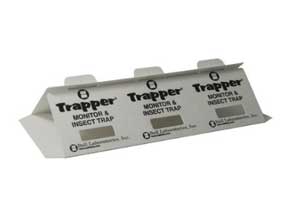Scouting out Bugs
If you think bugs are ‘icky’ you may pass on this blog post. But if you are like me and you find all things that go on in your world become fascinating, read on.
I have to admit that a few years ago when I heard about scouting out bugs (literal bugs) in the Museum, I thought it was a silly exercise. I assumed they couldn’t do much, if any, harm. But I am always willing to be proved wrong, and I was wrong.
Two years ago Maggie Stockel, our Registrar, took on the task to trap and identify any ‘critters’ in the Museum. Her reports to the board captured the attention of all the members, and resulted in several actions.
I’ll let Maggie take it from here:
When it comes to bugs, I have three goals: preventing access, monitoring activity and elimination when necessary.
Preventing access is a museum-wide job. It starts with physically blocking access by keeping all exterior doors and windows closed and in good working condition. New objects (packages, collections items, etc.) are inspected before entering the museum. Inside the building, we maintain temperature and humidity levels that are safe for collection items, but inhospitable to pests. Housekeeping is also imperative – collections and exhibition areas are kept free of trash, especially food waste, which has the potential to attract and feed pests. Food, of course, is not allowed in the exhibit areas.
No matter how excellent our prevention measures are, some pests will always be found inside. I monitor 20+ sticky traps strategically located in the museum and collections storage. Pests accidentally wonder into the traps and get stuck – I identify them and determine what they mean for our collection. Are they occasional invaders? Do they indicate poor environmental conditions? Or are they museum pests and a direct threat to our collections?
All objects, particularly those made of materials such as wood, fabric and paper, are vulnerable to a variety of insects. Below are a sampling of different types of pests found in museums:

Occasional invader: Spider
Spiders do not cause direct damage to collections, but will eat the insects that do! If I see a spider, I’ll catch it and let it free outside.

Environmental indicator: Pillbugs/Sowbugs/Woodlice
These bugs are attracted to damp, dark places where they scavenge algae, fungi, mosses and decaying plant and animal tissues. Pillbugs can indicate a problematically moist environment.

Adult Varied Carpet Beetle

Larval Varied Carpet Beetle and Casing
Larvae feed on many materials found in museum collections including: feathers, furs, silks, woolens, cottons, linens, and even dead insects and spiders.

Damage to a sweater (not in Museum’s collection) by Varied Carpet Beetle Larvae.
Here at the Schulz Museum, we have found a simple change in procedures can mitigate pest problems. Our exhibit cases are all on a regular cleaning schedule so that all materials attractive to pests (which can even include dust) are removed. We also relocated where catering for our large events occurs to ensure that more exterior doors remain closed during events and that food is prepared as far away from our collections as possible.
For more information about Integrated Pest Management in museums visit: museumpests.net
My favorite insect identification guide is the National Wildlife Federation’s Field Guide to Insects and Spiders of North America.




